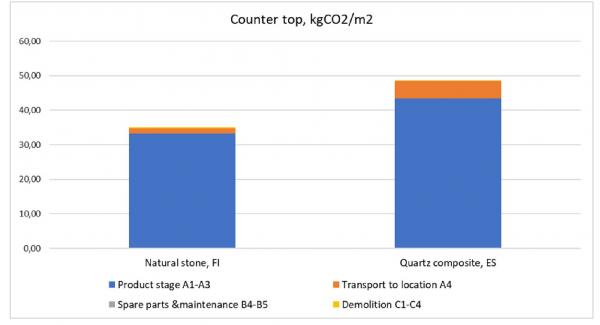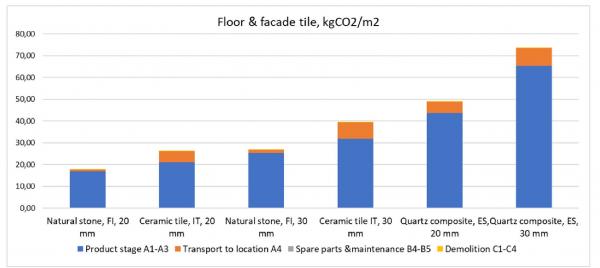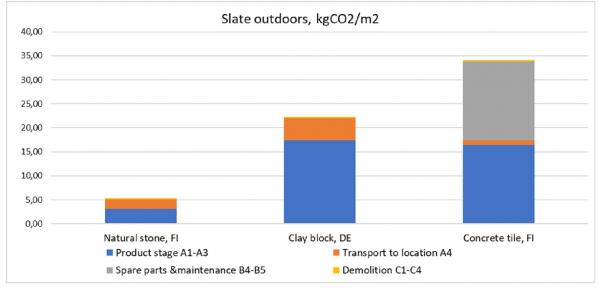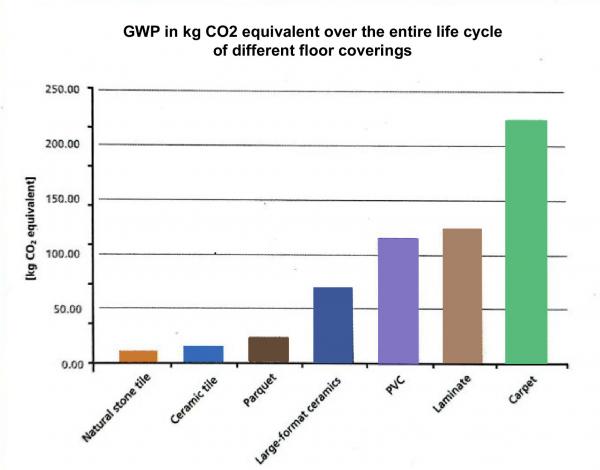INTRODUCTION
In recent years 'Sustainability' has become important, of the highest priority in any economic decision making and activity,and an almost obligatory company philosophy for any enterprise. However, for anyone trying to understand Sustainability, it is usually not easy, far too often any explanation or discussion lapses into technical data or use of different confusing terms.
This WONASA Guide is an attempt to explain Sustainability in a way that is easily understandable to the people working in the natural stone industry. Needless to say, anyone needing to understand and act on this topic in a detailed manner, will need to consult other sources, reports and studies.
WHAT IS SUSTAINABILITY?
Sustainability defies a simple, clear cut definition. In fact, there are different definitions and differences in the way it is understood by people, which is why there is often so much confusion in discussions and debates.
One widely used, and, a very general definition of Sustainability, is the one made by the UN World Commission on Environment and Development, which defines Sustainability as being: 'meeting the needs of the present without compromising the ability of future generations to meet their needs'. Sustainability, when understood through this very broad angle, is very about the future and not just focused on the present.
Another definition: "In essence, sustainable development is a process of change in which the exploitation of resources, the direction of investments, the orientation of technological development, and institutional change are all in harmony and enhance both current and future potential to meet human needs and aspirations.” Brundtland Commission in 1987
Yet another definition of Sustainability with a different choice of words, is in terms of human, social, economic and environmental effects – and these are often considered by many experts to be “The Four Pillars of Sustainability”.
WHY IS SUSTAINABILITY CONSIDERED IMPORTANT?
Global warming and the resulting harmful effects have now made Sustainability a top priority of mankind during the last few years.
Sustainability is supposed to have benefits both in the short-term and the long-term. The underlying assumption behind Sustainability is that to maintain the Earth’s ecosystems the world has to make more sustainable choices and stop functioning in the current way. The argument for sustainable choices lies, in practical terms, in the need for clean air and nontoxic atmospheric conditions, growth of resources that can be relied upon, water quality, cleanliness, etc.
WHAT ARE THE FEATURES OF SUSTAINABILITY?
There are several principles of Sustainability, and there is no unanimity on this among experts. However, the following principles are usually considered to be the defining features of Sustainability:
a).Circular economy. Aiming for resource efficiency through better waste management. ...
b).Energy Savings.
c).Sustainable material choices.
d). Life Cycle Assessment (LCA).
d).Environmental Product Declaration (EPD).
e).Constant research and innovation.
f).Corporate social responsibility.
THE LANGUAGE OF SUSTAINABILITY EXPLAINED
- What is Carbon Footprint?
The total amount of greenhouse gasses produced to directly and indirectly support human activities, usually expressed in equivalent tons of carbon dioxide (tCO2).”
- Carbon Neutral
Carbon neutral means a balance between emitting carbon and absorbing carbon from the atmosphere in carbon sinks. Carbon Neutral is NOT the same thing as Carbon Net Zero which implies making changes in economic activity to reduce carbon emissions to the minimum possible level and, in addition, offsetting to compensate for the essential emissions that are left after all reduction methods have been taken.
- Embodied Carbon
Embodied carbon refers to all the greenhouse gas emissions associated with production of products. For construction, these include the complete cycle of quarrying, transport, processing, installation, etc. Sometimes, this is also termed as "Carbon to Gate" embodied carbon in the construction industry. Sometimes people will refer to it by calling it "supply chain carbon".
- Life Cycle Assessment (LCA)
Life cycle assessment(LCA) can be defined as "systematic analysis of the potential environmental impacts of products or services during their entire life cycle" ( Source- Sphera). It means evaluating the potential environmental impacts throughout the entire life cycle (quarrying, processing, use and end-of-life phases). LCA also includes the suppliers, waste product management, production of raw, auxiliary and operating materials, and disposal. It covers all relevant inputs, (for example, water, land use, etc.), and it also includes emissions into the air, water and soil. For evaluation of ecological impact and comparisons many studies use a time period of 50 years for life-cycle phases, from production to usage.
Also considered in the LCA is any process done during the installation or use period of the product, such as the application of sealers during the life cycle of a countertop
- Circular Economy
The European Union defines it quite well : Circular Economy is a model of production and consumption which involves sharing, leasing, reusing, refurbishing and recycling existing materials and products as long as possible. At its core the Circular Economy is all about reducing or minimizing waste, and extending the life cycle of products.
- LEED (Leadership in Energy and Environmental Design).
In the USA, the Green Building Council developed the LEED System in 1994, it is a green building rating system. LEED provides a framework for efficient and cost saving green buildings. To date the LEED system does not use a complete life cycle assessment of the actual environmental performance of a building, it does a specific rating to all materials and building products that need to be transported less than 800 km to a construction site.
- Environmental Product Declaration(EPD)
a). What is EPD (Environmental Product Declaration)
An Environmental Product Declaration (EPD) is an independently verified and registered document that communicates transparent and comparable information about the life-cycle environmental impact of products in a credible way.
However, there is also a self-declared EPD process, so an EPD may not always be an independently verified document. Since these documents can be costly producers may have a hybrid system of verified EPD for higher volume products and some self-declared ones for lower volume products.
An EPD is a so-called type III environmental declaration that is compliant with the ISO 14025 standard. A type III environmental declaration is created and registered in the framework of a programme, such as the International EPD System
It is important to understand that there are essentially 3 types of EPDs.
- Average EPD. It refers to an EPD that covers similar products made by the same manufacturer. Similar products from a single or several manufacturing sites can be declared environmental performance as average results.
- Industry-wide EPD. A generic or industry-wide, EPD is one that is released by multiple manufacturers, often through a trade association, to publish the average footprint of the entire industry. This EPD does not cover individual products (a specific type of stone, for example), it basically accounts for the average product in a specific sector. A sector EPD declares the average product of multiple companies in a clearly defined sector in a clearly defined geographical area
- Product-specific. This EPD is the more rigorous in the sense that it covers a single product from a manufacturer. As an example, there can be an EPD for a specific stone with 2 cm in thickness located in a particular geographical location, and another stone with 3 cm in thickness.
b). Why is EPD becoming important?
The objective is to encourage the use of materials that have socially and economically preferable impacts on the planet and EPD is a way of life cycle assessment and a standardised way of quantifying the impact of a material on the environment.
How is EPD relevant to the natural stone industry?
When natural stone is being used mainly for decoration purposes (floorings, kitchen countertops, bathrooms,etc. in private homes) in small volumes, common sense dictates that EPD will normally be irrelevant as a criteria in decision making. Aesthetics and mechanical properties of the stones are likely to be more important considerations in these cases. Most likely the home owner would be creating more carbon emissions when driving in the car from his home just to go to the office, or to the supermarket.
But EPD becomes relevant as a building material, to be used in projects, in public or commercial buildings, where the measurement of ecological performance of different materials are an important criteria for architects and specifiers who, increasingly, are bound by the terms of the project, to consider life cycle assessments. Sooner or later, having an EPD number may end up being obligatory for a natural stone to be considered as an option in public procurement and in the private sector projects.
If any stone is being frequently used for projects, then it is advisable to get the EPD done for that stone, especially in 2 cm and 3 cm thickness, because these are the most common formats. If a stone is used frequently in exterior pavings in thickness such as 4 cm or more, then the EPD for that format could be obtained. For natural stones used principally for decoration purposes in small quantities, it is hard to understand why an EPD is necessary for that stone.
From different studies conducted in the last few years, in the case of natural stone life cycle assessment results have been excellent. As we all know, the primary energy consumed in extraction and processing is very low in the production cycle. Those who are working in the natural stone industry intuitively understand this, after all natural stone has evolved over tens of million years (when not hundreds of million years) in its creation, and no energy is needed to create it, as is the case with most alternative materials. Natural stone comes out of the quarry as a semi-complete building material, and the only energy needed thereafter is in its processing and transport, and in installation.
How is EPD measured?
To calculate the indicators required for an EPD of a natural stone, the LCA Consultant will ask principally for the following information:
- How and where the stone is obtained and its related resource use such as energy and water consumption
- The distance and transport mode of the stone to the plant
- Energy and resource use in production
- Delivery transport to customers
- End of life options available to the stone when discarded.
- Based on this information, the inventory of the whole product life cycle is obtained and these are then turned into environmental indicators by mainly using software tools.
How do the EPDs of natural stone compare with other alternative materials?
In 2019, the DNV (German Natural Stone Association) commissioned a study by the Institute of Construction Materials at the University of Stuttgart, which compared the ecological and economic impacts of different floor coverings from the production to the use phase.
The data was collected from existing environmental product declarations (EPD) issued by the various building material manufacturers. Natural stone floor coverings predictably achieved very good life-cycle assessment results, due to the low primary energy demand of the stone.
A comparison of all floor coverings showed that those produced from natural stone cause a significantly lower environmental impact in their production, installation and use than large-format ceramics, carpets, PVC, laminates, and parquet.
In the category of global warming potential (GWP) impact, the production and utilization of floor coverings using natural stone tiles display significantly lower CO2 equivalents than the production and use of other covering materials.
Some examples of CO2 emissions comparisons (Natural stone from Finland)



Comparison of CO2 emissions (DNV Study)

WHO DOES THE EPD STUDIES?
In many countries there are recognised entities which have the expertise to conduct these studies and their certificates should be valid internationally.
TO SUMMARIZE, WHY NATURAL STONE?
- No energy is needed for creation of natural stone, that process has evolved over millions of years. Energy use is for extraction and processing.
- It is a reusable product.
- It has demonstrated its durability over centuries.
- There are no pollutants in natural stone, it is an inert material and can be returned to the natural material cycle easily.
- Natural stone contains no harmful substances.
- It is fire resistant.
- Water recycling in the fabrication process.
- Environment green program is nowadays mandatory in most countries before the extracting companies get licence to extract natural stone.
- There is low CO2 emission in the fabrication process.
SOME USEFUL LINKS
German Stone Association (DNV) Studies-
KIVI (Finish Stone Association) report- https://kivi.info/kivi-ry/kivi-stone-from-finland
Metsims Consulting- https://metsims.com
Silkar study https://Silkarstone.com/documents/safe-and-green-buildings
WONASA video on Polycor- https://youtu.be/Gwn8XGTLU4c
WONASA Seminar on Sustainability Video-https://youtu.be/uIfJ7gq8kfg
In Spanish:
Cluster de Granito- https://www.piedra.online/publicaciones/dap-revestimientos-de-granito
For the elaboration of this Guide many sources and people have been consulted. In particular, our thanks to Mr Hudai Kara, Mr Daniel Brum, Ralph Morgan among others,and to organizations like the German Stone Association( DNA) and the Finnish Stone Association (KIVI).
November, 2022
